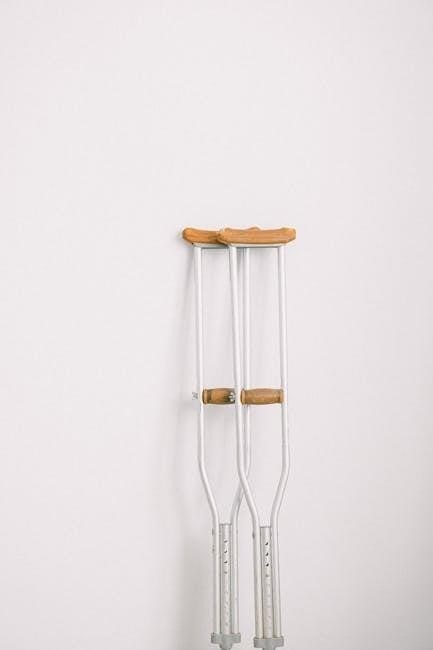The total hip replacement rehabilitation protocol pdf provides guidelines for recovery and rehabilitation after surgery, including physical therapy and exercises to improve mobility and strength, using a structured approach.
General Summary and Recommendations
The total hip replacement rehabilitation protocol pdf outlines a comprehensive approach to recovery, emphasizing the importance of a structured rehabilitation plan tailored to individual patient needs.
The protocol provides guidelines for healthcare professionals to develop effective treatment strategies, promoting optimal outcomes and minimizing complications.
A thorough understanding of the rehabilitation process is essential for successful recovery, and the protocol serves as a valuable resource for patients and healthcare providers alike, facilitating a smooth transition from surgery to rehabilitation.
The recommendations outlined in the protocol are based on current best practices and evidence-based research, ensuring that patients receive the most effective care possible.
By following the guidelines and recommendations outlined in the protocol, patients can expect to achieve significant improvements in mobility, strength, and overall function, ultimately enhancing their quality of life.
The protocol’s emphasis on patient-centered care and individualized treatment plans enables healthcare providers to deliver high-quality, personalized care.

Precautions and Restrictions
Patients must avoid heavy lifting and bending to prevent complications and ensure a smooth recovery process always.
General Precautions and High Impact Activities
General precautions are necessary to ensure a safe and effective recovery after total hip replacement surgery. Patients should avoid high impact activities such as running, jumping, and heavy lifting, as these can put excessive stress on the new hip joint. Instead, low impact activities like walking, swimming, and cycling are recommended. It is also important to avoid bending, twisting, and turning, as these movements can dislodge the new hip joint. Patients should use assistive devices like canes or walkers to help with mobility and balance. By following these precautions, patients can reduce the risk of complications and ensure a smooth and successful recovery. A well-structured rehabilitation protocol can help patients achieve optimal outcomes and improve their overall quality of life. Regular follow-up appointments with the healthcare provider are essential to monitor progress and address any concerns.
Hip Implants and Surgical Approaches
Hip implants consist of a femoral stem and acetabular cup, with various surgical approaches available, including anterior and posterior methods, using a metal socket.
Components of Hip Implants and Surgical Methods
The components of hip implants include a femoral stem and an acetabular cup, which are designed to work together to provide a smooth and stable joint. The femoral stem is inserted into the thigh bone, while the acetabular cup is attached to the pelvis. There are different types of surgical methods used to implant these components, including cemented and uncemented procedures. The choice of surgical method depends on various factors, including the patient’s age, bone quality, and overall health. The surgical method used can affect the outcome of the surgery and the patient’s recovery time. Additionally, the design and materials used in the hip implant can also impact the success of the surgery and the patient’s long-term mobility and comfort, with some implants being more suitable for certain types of patients.

Pain Management and Treatment Protocols
Pain management includes reducing narcotics and side effects using various treatment protocols and medications for optimal recovery and comfort, with a focus on patient care.
Adequate Preoperative Pain Measures and Medications
Adequate preoperative pain measures are crucial for a successful total hip replacement rehabilitation protocol, as they help reduce anxiety and discomfort.
The use of medications such as non-steroidal anti-inflammatory drugs and opioids can be effective in managing pain.
Additionally, alternative methods like acupuncture and physical therapy can also be used to reduce pain and inflammation.
It is essential to consult with a healthcare professional to determine the best course of treatment for each individual.
A comprehensive pain management plan should be developed preoperatively to ensure a smooth and comfortable recovery.
This plan should include a combination of medications, therapies, and lifestyle modifications to manage pain and promote healing.
By taking a proactive approach to pain management, patients can reduce their risk of complications and improve their overall outcomes.
Effective pain management is critical for a successful rehabilitation protocol.

Revision Total Hip Replacement Rehabilitation
Revision surgery requires additional precautions and confirmations to ensure successful rehabilitation and recovery, using a customized approach and treatment plan, with specific guidelines.
Additional Precautions and Confirmations
Revision total hip replacement rehabilitation requires careful consideration of additional precautions and confirmations to ensure a successful outcome.
The rehabilitation protocol should be tailored to the individual’s specific needs and circumstances, taking into account any potential complications or risks.
A thorough assessment of the patient’s condition and medical history is essential to identify any necessary precautions or modifications to the rehabilitation plan.
The patient should be closely monitored and evaluated throughout the rehabilitation process to ensure that they are progressing as expected and to make any necessary adjustments to the treatment plan.
This may involve regular follow-up appointments with the healthcare team and ongoing communication to address any concerns or questions.
By taking a careful and individualized approach to revision total hip replacement rehabilitation, patients can minimize the risk of complications and achieve the best possible outcome.

Rehabilitation Protocol and Treatment Plan
Rehabilitation plans include physical therapy, exercises, and pain management to restore hip function and mobility, using a structured approach and timeline for recovery and rehabilitation activities.
Improved Function and Recovery of the Hip Joint
The rehabilitation protocol aims to improve function and recovery of the hip joint, enabling patients to regain mobility and strength.
A well-structured approach is essential for optimal recovery, including physical therapy and exercises tailored to individual needs.
The goal is to restore hip function, reducing pain and discomfort, and enabling patients to return to normal activities.
Rehabilitation plans are designed to promote healing, prevent complications, and ensure a smooth transition to normal life.
By following a comprehensive rehabilitation protocol, patients can expect significant improvements in hip function and overall quality of life.
The recovery process involves a series of stages, each with specific objectives and outcomes, ultimately leading to improved function and mobility of the hip joint.
Effective rehabilitation is critical for achieving optimal outcomes and ensuring a successful recovery from total hip replacement surgery.
